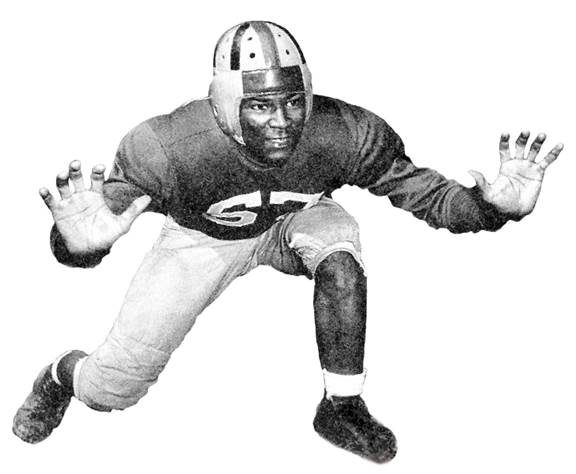

CINCINNATI'S TAFT HIGH SCHOOL BACKFIELD, Part Two
HELMET HUT NEWS/REFLECTIONS January 2017:
CINCINNATI'S TAFT HIGH SCHOOL
BACKFIELD, Part Two
By Dr. Ken
The Cincinnati Robert
Taft High School feature
in the HELMET
NEWS/REFLECTIONS article
of November 2016 noted
the rare backfield
talent that brought four
eventual National
Football League players
together as a powerhouse
quartet. That the
sophomore of the group,
Carl Ward who would star
at Michigan and later
for the Cleveland Browns
could not crack the
starting lineup despite
already flashing his
immense abilities,
speaks rather
descriptively of that
Taft Senators squad.
Head Coach Will Stargel
was a local hero, one of
the first African
Americans to lead the
University of Cincinnati
football and track teams
in his years there that
began in 1941. His
collegiate studies and
athletic career were
interrupted by World War
II and after serving
with the Fifth Army, he
returned to contribute
to UC’s 1946 team that
compiled a 9-2 record
and a Sun Bowl victory.
As a letterman in
basketball and a track
athlete that set low and
high hurdles records
that were not broken
until his son Scott did
so in the ‘60s, Stargel
was later inducted to
the University of
Cincinnati Athletic Hall
of Fame and was a
natural leader for the
Taft High School
Athletic program.
However, even by 1960,
like so many of the
Cincinnati inner city
schools, he had to fight
to overcome poor
facilities and a lack of
student academic
success.
Former UC Bearcat
star Will Stargel
remained a local
hero and dedicated
himself to the young
men and women of
Cincinnati’s Robert
Taft High School
Losses to private
schools Purcell (now
Purcell Marian High
School whose 1959
squad was led by
Roger Staubach) and
Roger Bacon did not
reduce the interest
of college scouts
who flocked to
recruit the stacked
backfield of Walter
Johnson, Al Nelson,
Cleophus Edwards,
and Carl Ward. Of
this group, Al
Nelson was the only
one who chose to
remain close to
home. The 9.8/100
yard sprinter who
won the Public
School League titles
in the 220 and 440
yard sprints wanted
to remain in town,
in part to be near
his mother. Taft’s
left halfback who
included a 105 yard
interception return
among his many high
school
accomplishments
said, “I could have
gone to a bigger
football school but
I preferred to stay
home. Besides, at
that time, we got
$15.00 per month for
laundry. I took the
money and brought
the laundry home to
my mother.” At the
University of
Cincinnati, Nelson
immediately made an
impression, not only
with his outstanding
speed but with his
ability to take his
5’11”, 175 pound
frame and burst
through tackles
running for the
tough yardage.
